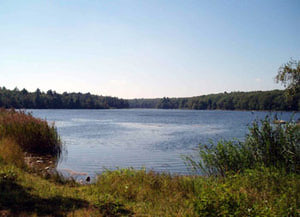Freshwater Lakes
Introduction
Freshwater lakes are bodies of still, unsalted water surrounded by land. They are usually found in low laying areas and are fed from streams, rivers and runoff from the surrounding area. Freshwater lakes provide a unique habitat for microbes because they differ from other aquatic habitats such as oceans and moving water. This habitat is home to a plethora of microbes such as proteobacteria, actinobacteria, cyanobacteria, and bacteroidetes. These microbes help sequester inorganic compounds, mineralize nitrogen, and decompose organic matter, as well as other important processes.
In the introduction, briefly describe the habitat that is the topic of this page. Introduce the habitat, its ecological significance, and the importance of microorganisms in this environment. (What processes do they carry out? What functions do they perform?)
Physical environment
Physical
Freshwater lakes are formed in a variety of different ways and depending on how a lake was formed, it can affect the microbes that are able to live and survive. Common types of lakes are stream or river fed lakes, glacial lakes, which are created by melting glaciers, and artificial lakes, which can be formed by the addition of a dam from old mines or quarries which have filled in after use. Another more unique lake type is a subglacial lake, which is a lake permanently covered by ice such as in Antarctica.
River Fed
These lakes have their input and output from rivers. This differs then from other types of lakes because they can receive storm water run off from not only the surrounding area but from all the areas in the basin of the lake and feeding rivers.
Subglacial
A subglacial lake is one in which there is flowing water under a glacier, ice cap, or ice sheet. They are found is regions such as Antarctica which are constantly under the freezing point. Only certain types of unique bacteria are able to thrive in such environments. This is also the only type of lake which is known to exist in an extraterrestrial location. Jupiter’s moon Europa’s surface is entirely covered in an ice sheet, and it is believed to be one of the most likely locations for extraterrestrial life.
Artificial
These include lakes formed from dams,man-dug, or mines and quarries.
Dammed
Dammed lakes are fed by rainwater and inflow of a river, and drain from outflow from drains on the dam. Water quality testing is done often in this type of lake to insure the dam or other inputs are not polluting the water.
Man Dug
These lakes only receive water run off from the surrounding areas and precipitation. Lakes such as these are often built near roadways and other urban areas and have a higher about of pollutants than more natural lakes.
Mines/Quarries
Old and abandoned mines and quarries often become lakes because most require the use of water control devices to keep ground water from seeping in. Lakes formed this way often have high amounts of contamination due to chemicals and machinery used in the harvesting process.
Chemical
Many factors contribute to the chemical environment in which lake microbes live. These include the drainage basin, the amount of water flowing in and out of a lake, the concentrations of nutrients and dissolved oxygen, the pH, and any pollutants and sedimentation in a lake. The overall drainage basin will affect the amount of run off from other sources in the surrounding area, which will, in turn, affect the amount of nutrients available to microbes and will increase pollutants and sedimentation. The lake level, which is regulated by inflow and outflow of a lake, the pH and the dissolved oxygen content in a lake, will also determine what types of microbes can survive because each microbe has its own unique environmental conditions in which it can outcompete the competition.
Microbial communities
What kind of microbes do we typically find in this environment? Or associated with important processes in this environment? Describe key groups of microbes that we find in this environment, and any special adaptations they may have evolved to survive in this environment. List examples of specific microbes that represent key groups or are associated with important processes found in this environment. Link to other MicrobeWiki pages where possible.
Are there important biological interactions that are important in this environment? Do these interactions influence microbial populations and their activities? How do these interactions influence other organisms? Describe biological interactions that might take place in this environment, using as many sections/subsections as you require. Look at other topics available in MicrobeWiki. Create links where relevant.
Subsection 1
Subsection 1a
Subsection 1b
Subsection 2
Microbial processes
What microbial processes define this environment? Describe microbial processes that are important in this habitat, adding sections/subsections as needed. Look at other topics in MicrobeWiki. Are some of these processes already described? Create links where relevant.
Subsection 1
Subsection 1a
Subsection 1b
Subsection 2
Current Research
Enter summaries of recent research here--at least three required
References
Edited by <your name>, a student of Angela Kent at the University of Illinois at Urbana-Champaign.

